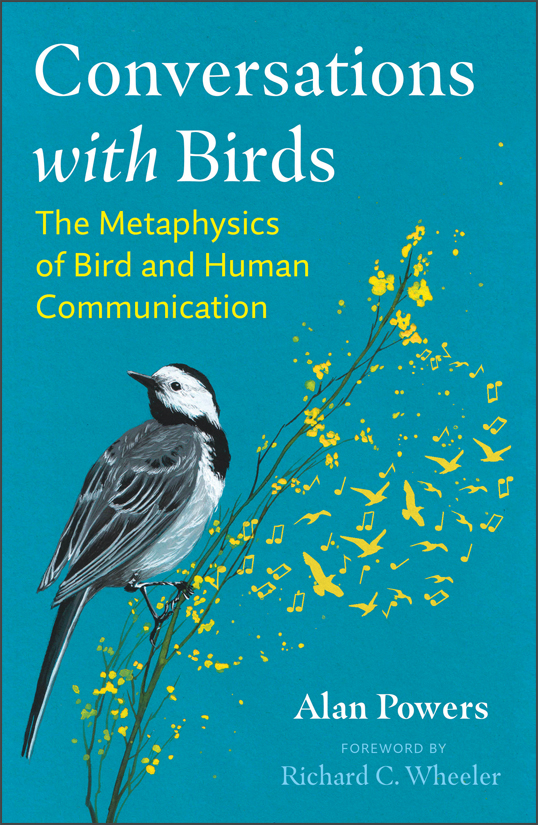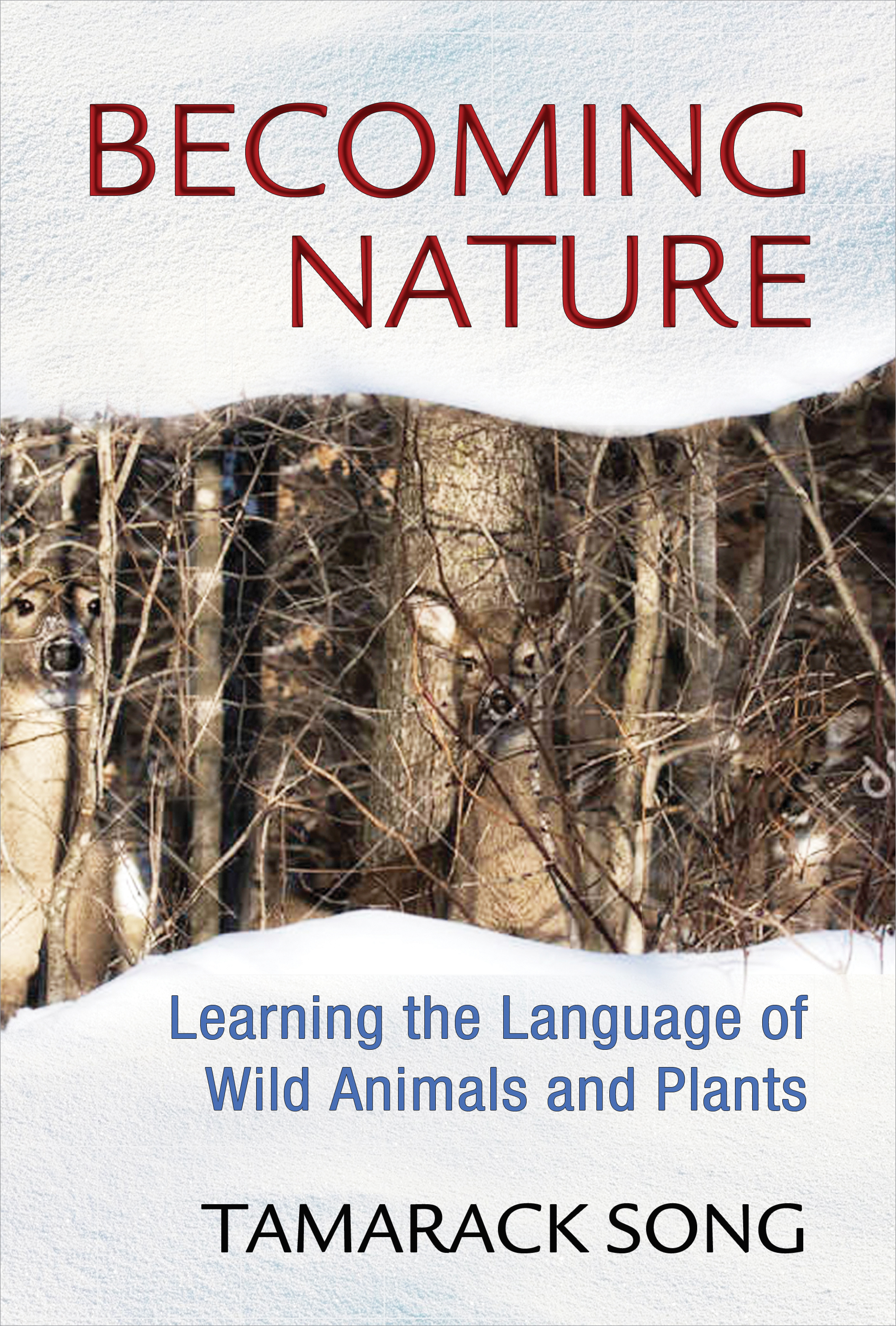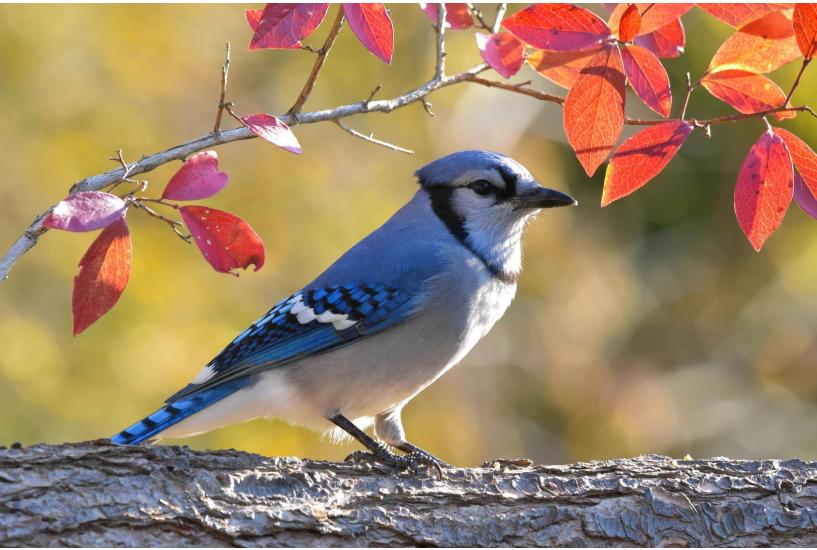Bird Talk
by Alan Powers, author of Conversations with Birds
What do we hear when we listen to birds? What for us may seem a melodic interval may be a desperate and distressed plea. What passes as hostile assault between two Titmice (even one precipitating avian “battery” as well—pecking tailfeathers and so on) may sound like a musical fugue. Even to call bird sounds “song” is to project a certain relatively narrow range of human activity. For birds, what we call their “songs” are more often curses and threats, defiance or concession, arrests and apprehensions, or even weather bulletins and realty leases. We simians do not tend to “sing” upon being stopped for speeding; a bird would. Nor do we “sing” when a deadly enemy approaches our home to steal and possibly eat our offspring. Or if we do sing on such occasions, we are doubtless onstage in a Greek tragedy or grand opera.
We should think a bit before we apply human behavior to birds. One way is to reverse the bird studies. Would such assessments of birds make sense if they were about us? For instance, ornithologists classify most avian behavior under territory, mating, and feeding. The brave scientists add migration, although because it is not well understood—often migratory and non-migratory branches of the same species share territory—very few studies link migration and “song.” Now, if we reverse these studies, we say that most human behavior falls under social and sexual life, finding a place to live, and food. The brave sociologist or psychologist adds travel or “migration”—a fairly accurate term for American retirees flocking to Florida or Arizona.
Almost all human behavior can be reduced to such elemental necessities. Clothes and jewelry? Mating behavior. Cars, roads, and fences? Territorial determination. Agriculture, restaurants, and TV chefs? Feeding. I suppose one could subdivide the whole world economy and every separate culture into such basic categories. I feel, as a human, that such reductive classification, commonly practiced in field studies of birdsong—and arguably practiced in certain branches of anthropology and especially psychology (Maslow’s “hierarchy of ends”?)—such classifying does not adequately assess my communications and expressions.
Mysteries abound in the songs, or the curses and threats, of birds. In his chapter “Emotions” in The Minds of Birds, Alexander Skutch attributes human emotions to bird vocalizations. His approach inherently questions the usual scientific assessment of bird-speak for its function or use—either to establish a mating or feeding territory, to attract (or, logically, to repel) a mate, to signal the male’s readiness to take over egg incubation, and so on. Skutch notes that we human observers find or project our own emotions:
“It is remarkable how often the sounds that birds make suggest the emotions that we might feel in similar circumstances: soft notes like lullabies while calmly warming their eggs or nestlings; mournful cries while helplessly watching an intruder at their nests; harsh or grating sounds while threatening or attacking an enemy; sharp, castanet-like clacking of the bill while trying to intimidate a rival or an interloper. Birds so frequently respond to events in tones such as we might use that we suspect their emotions are similar to our own. Some birds, however, appear to lack notes appropriate for harassing occasions.” (1996, 42)
That is, they have only beautiful songs! Ah, to be hemmed in and confined to beauty—to be relegated, like Midas to gold, to speak only poetry.
Skutch notes a function of birdsong identified by only a few other ornithologists, the propensity of a nesting bird such as a Flycatcher to “voice a little nest song as she passed through the doorway in the side of her bulky roofed nest and snuggled down on her two speckled eggs. Sometimes she twittered softly in the midst of a session of incubation and at intervals she called more loudly and was answered by her mate” (Skutch 1996, 37). One easy way to assess birdspeak is to differentiate the bird’s tone from what human speech would be in an analogous situation. For territorial calls, we may expect the human male to beat his breast, ape-like, or to sing and play a rock song on amplified guitar. Or possibly the territorial call is closer to a real estate closing, with two sets of lawyers, bank reps, new owner, and so on. Somehow, the Wood Thrush and the Catbird win this comparison either way.
Reversing the analogy, what if humans could only sing beautifully, no matter the occasion? We would be living in Verdi or Donizetti or Gershwin. And who can doubt that after their silence of a cold autumn evening, birds chatter more at the advent of sunlight? No matter their various songs; they all may be singing, really expressing overflowing emotion, as if they knew “O sole mio”.
Just over a century ago in Naples, Giovanni Capurro wrote, “What a beautiful thing it is, the daylight, the sun / In the peaceful air after a storm, / The air so clear it’s like a party already, / What a beautiful thing, the sunshine” (my translation). Once Di Capua set this to music, the birds I heard this October morning could well agree. I suspect that much birdspeak is also weather-related, often seasonal but also daily or circadian.
By the first week of November, the birds are flocking, gathering among the leafless branches “where yellow leaves or none or few do hang,” as Shakespeare put it. There are Jays in abundance, a dozen here in the scrub oaks, and Robins as well, several dozen. I try out the piped descending minor third that worked a couple of weeks ago; it called a lone Jay across the parking lot. But this morning none responds. They hang together hopping among the bare branches. They do seem agitated; maybe it’s their version of Zugunruhe, premigration restlessness. They vocalize in a kind of chee, also imitable by in sucking, but lower than the Osprey. Today Robins, like the Jays, ignore my usual, burbling Robin salute. Nor do they hail each other in their characteristic calls.
I conclude that flocking and migratory birds have no use for their characteristic songs. When their behavior changes, their language changes. Their usual calls imply certain significant spaces between them; such songs might be compared to operatic passages, inappropriate in a crowded subway or taxi. Their usual songs also suggest greater individuation than during migration. Remarkably, they no longer regard calls that were answered just two weeks earlier. A comparison in human behavior might be joining the army and its attendant haircut and uniform. Birdsong functions as do civilian hair and attire, as well as property deeds.
Many birds also mimic. At least, we hear their birdtalk as imitation. Mockingbirds are named for this ability, but they are not alone in this. Blue Jays can imitate almost as well, although they don’t do it from the tops of trees in rapid succession. While Mockers appear to perform gratis—thespians incarnate (or pennate)—Jays use mimicry to lurk and then to surprise their prey. Who is the better mimic, the one everyone knows is imitating, or the one we don’t notice? If the Mockingbird delights like an actor or even a parodist, the Blue Jay, like a double agent, prefers the shadows. He talks clandestinely in several bird dialects.
One mid-February morning in a dusting of snow, I heard an apparent Carolina Wren repeat a grace note and descending minor third. Looking for the bird typically halfway up some leafless bush, I could not find it. After several exchanges, I finally saw a Blue Jay low to the ground. Once I saw it, it made a guttural caw like a small Crow. In Bird Sounds, Barry MacKay comments on such Jay ability, and on the nature of mimicry:
“Blue Jays have a call that is similar to that of Red-Tailed Hawks. Whether or not this derives from true mimicry, the cry so closely resembles that of the raptor that some birders do not assume that a hawk’s call actually comes from a hawk until they see the hawk make the call.” (2001, 46)
Blue Jays, then, make a wide variety of non-Jay calls. Many of these apparently deceive, like duck hunters quacking from a blind.
When are similar songs true mimicry? The story of bird mimicry does not begin and end with deception and parody. In my book Conversations with Birds, I start by looking at a wide variety of birds making similar sounds and intervals—descending minor thirds, ascending fourths, glissandos. Would it be too much to call this the lingua franca of the species? It may well turn out that certain sounds are universally recognized among birds. Surely their warnings, the fricative chuck-chucks and in-sucking lisps, are clear even to simians. What then can they make of each other’s’ descending minor thirds? Do they function like stone walls in New England? Or like answering the phone? They do seem to hold a function quite beyond any imitation or mockery.
 |
 |
 |
 |
 |



